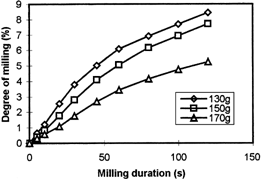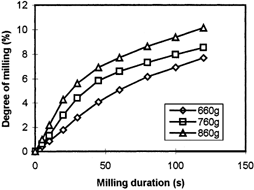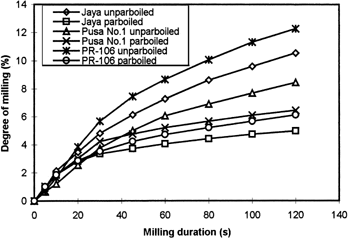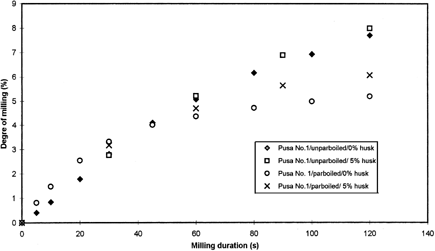ABSTRACT
Three different rice cultivars varying in length breadth ratio were parboiled. The effects of weight of sample milled and weight applied on the mill chamber on the degree of milling, length breadth ratio, head rice yield, thousand kernel weight and bulk density of milled rice were studied. It was observed that the degree of milling was inversely proportional to the weight of sample being milled and directly proportional to the weight applied on the mill chamber during milling. Parboiling led to an increase in the milling duration for the same degree of milling. Cultivars with higher length breadth ratio showed higher degree of milling for the same milling duration. The presence of husk in the mill chamber during the polishing process resulted in an increase in the degree of milling. The coefficients of regression models determined had high R 2 values and can be used to predict the degree of milling of unparboiled and parboiled rice for the three different cultivars.
INTRODUCTION
Rice (Oryza sativa L.) is the second most important cereal crop of the world and serves as the staple food for a large segment of the world's population. Dehulling is the first step in its processing and yields brown rice. The second step is polishing or removal of bran to yield white or polished rice. This is the stage in which most of the breakage occurs. Brown rice is more nutritious but is not generally consumed because it has a poor appearance and lower digestibility and therefore it has to be polished. The degree of milling (DOM) is expressed as weight percentage of bran removed from brown rice Citation[1]. Adjusting DOM during the rice milling operations is essential for optimizing quality and economic return.
DOM is important in determining the grade of milled rice as it may effect head rice yield levels, insect infestation, starch gelatinization and sensory quality Citation2-6. DOM is an important factor in terms of the nutritional value and the economic return of the milled rice. Vellupillai and Pandey Citation[7] reported that 65–73% of the bran was removed in the first 20 s of milling. As milling time increases head rice yield decreases and DOM increases Citation[8]. Parboiling is a common processing practice used to improve the quality of rice. Parboiling reduces breakage during shelling and polishing Citation9-11. Parboiling treatment increased milling resistance resulting in under milled rice and there was need for more abrasive milling Citation[12].
The effect of kernel size on milling performance and quality has been studied Citation[2], Citation13-14. Matthews and Spadaro Citation[15] reported that breakage of milled rice was generally greater for thinner fractions and the amount of bran removal in milling increased with decrease in rough rice kernel thickness. Head rice yield and DOM can be influenced by the amount of weight applied to the milling chamber during milling. Webb and Calderwood Citation[16] increased weight setting on the miller to obtain equivalent DOM. However no mention was made of how or by what amount the weight was increased. No other studies were found pertaining to the effect of weight applied to the rice during milling.
The objectives of the present investigation were to study the milling behaviour of different unparboiled and parboiled rice cultivars, the effect of milling variables (milling duration, weight applied, amount of sample in the mill chamber) on DOM and head rice yield of unparboiled and parboiled rice and the effect of presence of husk in the mill chamber on the DOM of unparboiled and parboiled rice.
MATERIALS AND METHODS
Parboiling
A traditional village method of parboiling was followed. The paddy was soaked in water at 25°C for 48 h. The soaking water was changed every four hours to prevent anaerobic conditions and excessive microbial growth. After soaking the paddy had a moisture content of 28.6% (wb) and this was then steamed at 100°C for 20 min in a steamer. The steamed paddy was dried in a cabinet drier at 35°C to a moisture content of 12% (wb).
Milling
Jaya, PR-106 and Pusa No. 1 were collected from Punjab Agricultural University Rice Research Station from 1998 harvest and had moisture content in the range of 12% (wb). The paddy samples were dehusked at 12% moisture content (wb) on McGill Rice Miller No. 2 (Rapsco, Brookshire, TX, USA). The whole brown rice kernels (130 g, 150 g, 170 g) were separated from the broken kernels and milled in triplicate in a McGill Miller No. 2 (Rapsco, Brookshire, TX, USA) for 5, 10, 20, 30, 45, 60, 80, 100, and 120 s. The McGill rice polisher is a friction type polisher which makes use of pressure created during rubbing action between the grain and mill screen. The pressure on the rice during milling was controlled by placing a weight (660 g, 760 g and 860 g) on the mill lever arm at a distance of 2l.5 cm from the centre of the saddle to the centre of the weight Citation[17]. The mill was thoroughly cleaned after each milling interval by brushing the bran and broken rice kernels from screen and rotor. The effect of husk on DOM was studied by adding 5% husk to 150 g of brown rice in the milling chamber during each milling interval. DOM was determined by using the following expression
Length breadth ratio was determined by dividing the length of ten kernels by the width of ten kernels. Mean of ten replications was reported. 1000 kernel weight was determined by weighing 1000 kernels. Mean of three replications was reported. Weight of 1000 mL of rice kernels was taken as the bulk density and was reported in g/l. Mean of three replications was reported. The kernels that were 75% or more of their original length were considered as head rice. Head rice yield was determined using the following expression.
Statistical Analysis
Regression analysis was carried out using Minitab Statistical Software (Minitab Inc. USA) to compute second order polynomials. X 1, weight (g) of rice sample placed in the mill chamber; X 2, has a value of 1 for unparboiled sample and 2 for parboiled sample and X 3, is the duration of milling in seconds. The polynomials were fitted to measure the DOM. The equation used was as follows.
RESULTS AND DISCUSSIONS
Effect of Weight of Sample Milled
The brown rice obtained from the three rice cultivars Jaya, PR-106 and Pusa No. 1 had length breadth ratio of 2.70, 3.48 and 4.23, respectively. The DOM decreased with increase in the size of sample in the mill chamber. It is clear from Fig. that percent bran removed was higher when less amount of rice was placed in the mill chamber. DOM was maximum in case of PR-l06 followed by Jaya and Pusa No. 1 for unparboiled rice where as for parboiled rice the DOM was maximum in case of Pusa No. 1 followed by PR-106 and Jaya (Table ). Fig. shows that the DOM of parboiled rice is lower than that of unparboiled rice. It is well known that parboiling leads to increase in hardness of the grain resulting in reduced DOM Citation[18].
Figure 1. Effect of weight of sample (unparboiled Pusa No.1) milled in the mill chamber on degree of milling.

Effect of Weight of Sample Milled on Different Parameters After 120 s of Milling
For parboiled rice the DOM was directly proportional to the length breadth ratio but in case of unparboiled rice this trend was not observed. This may be attributed to the presence of mealy and chalky endosperm in Jaya and PR-106 and flinty endosperm in Pusa No. 1. After parboiling the endosperm becomes hard and the kernels having the same hardness but higher length breadth ratio showed higher DOM.
Multiple regression analysis was carried out to determine coefficients so that the DOM could be predicted when the weight of sample (unparboiled or parboiled) in the mill chamber is varied. The coefficients of the regression model are given in Table and the R 2 value indicates that the model can be used to predict the DOM. Table shows the effect of weight of rice milled for 120 s from different unparboiled and parboiled rice cultivars on various physical parameters. The cultivars having lower length breadth ratio were found to have higher bulk density. Increase in the weight of sample being milled in the mill chamber led to an increase in the length breadth ratio, head rice yield and thousand kernel weight but decreased the bulk density. Both length breadth ratio and 1000 kernel weight are directly related to the DOM. Lower the DOM lesser is the amount of bran removed from the rice kernels and thus higher the length breadth ratio and 1000 kernel weight. The rice kernels milled to lower DOM had larger size resulting in a decrease in bulk density. The head rice yield increased with the increase in sample size since the DOM was lowered because of less friction and this led to a decrease in the number of broken kernels. Parboiling led to a decrease in the bulk density in all rice cultivars which may be due to the expansion of the kernels as indicated by the increased I/b ratio.
Regression Coefficients Showing the Effect of Weight of Sample Placed in the Mill Chamber on Degree of Milling
Effect of Weight Applied on DOM
DOM was higher when the weight applied on the mill lever arm was higher (Fig. ). This is because the increase in weight on the rice during milling increased the abrasive forces of friction and thus increased the DOM. Rice (150 g) was placed in the mill chamber and the weight on the mill lever arm was varied from 660, 760 to 860 g. For unparboiled rice the DOM was maximum in case of PR-106 followed by Jaya and Pusa No. 1. For parboiled rice the DOM was maximum in case of Pusa No. 1 followed by PR-106 and Jaya.
Figure 3. Effect of weight applied on the mill chamber on the degree of milling (unparboiled Pusa No.1).

The DOM was 8.91, 9.77 and 11.4%, respectively, for unparboiled and 4.17, 4.66 and 5.09% for parboiled rice from Jaya cultivar. DOM for unparboiled PR-106 rice was 10.02, 12.44 and 15.42%, respectively against 4.69, 5.38 and 6%, for parboiled rice from same cultivars. Where as for unparboiled Pusa No. 1 the DOM was 7.7, 8.54 and 10.14% and for parboiled it was 5.18, 5.63 and 6.14% respectively. Increasing the weight on the mill lever arm also lead to a decrease in the l/b ratio, 1000 kernel weight and head rice yield but increased the bulk density (Table ). The coefficients of the regression model are given in Table and the R 2 value indicates that the model can be used to predict the DOM.
Effect of Weight Applied on Sample Milled on Different Parameters After 120 s of Milling
Regression Coefficients Showing the Effect of Weight Placed in the Mill Chamber on Degree of Milling
Effect of Husk During Milling
Presence of husk in the mill chamber increased the DOM (Fig. ). This could be attributed to the abrasive nature of the husk which is high in silica Citation19-20. The DOM in unparboiled Jaya, PR-106 and Pusa No. 1 was 8.91, 10.02 and 7.70% respectively after 120 s of milling and increased to 9.04, 12.40 and 7.81% with the addition of 5% husk. While parboiled rice showed DOM of 4.17, 4.69 and 5.18%, respectively in Jaya, PR-106 and Pusa No. 1 after 120 s of milling which increased to 4.56, 4.91 and 6.07% with the addition of 5% husk. During the milling of parboiled rice there was clogging of the mill screen. This is due to the increased oil content in the parboiled rice bran Citation[21]. The presence of husk in the mill during polishing prevented the clogging of the mill screen. The effect of husk on the DOM is described by equations in Table .
Relationship Between Degree of Milling and Milling Duration in the Presence of Husk
CONCLUSION
This study revealed that different rice cultivars vary in their milling characteristics. Milling variables like amount of rice in the mill chamber and weight applied on the mill chamber significantly affects the DOM, length breadth ratio, bulk density and 1000 kernel weight of the different rice cultivars. Lower the amount of rice placed in the mill chamber and higher the weight applied on the mill lever resulted into higher DOM in both unparboiled and parboiled rice from all rice cultivars. Parboiling led to an increase in hardness of the rice kernels and thus lowered the DOM. Cultivars with higher length breadth ratio showed higher DOM. Addition of rice husk in the mill chamber during milling of brown rice increased the DOM. Regression equations developed had high R 2 values and can be used to predict the DOM.
Acknowledgments
REFERENCES
- Wadsworth , J.I. , Sequeira , D.J. and Vellupillai , L. 1991 . “ Rice Degree of Milling Measured by NIR ” . In ASAE Paper 91-6030 ASAE MI : St. Joseph .
- Sun , H. and Siebenmorgen , T.J. 1993 . Milling Characteristics of Various Rough Rice Kernel Thickness Fractions . Cereal Chemistry , 70 : 727 – 733 .
- McGaughey , W.H. 1970 . Effect of Degree of Milling and Variety on Insect Development in Milled Rice . Journal of Economic Entomology , 63 : 1375 – 1376 .
- Champagne , E.T. , Marshal , W.E. and Goynes , W.R. 1990 . Effect of Degree of Milling and Lipid Removal on Starch Gelatinization in the Brown Rice Kernel . Cereal Chemistry , 67 : 570 – 574 .
- Marshal , W.E. 1992 . Effect of Degree of Milling of Brown Rice and Particle Size of Milled Rice on Starch Gelatinization . Cereal Chemistry , 69 : 632 – 636 .
- Piggrott , J.R. , Morrison , W.R. and Clyne , J. 1991 . Changes in Lipids and in Sensory Attributes on Storage of Rice Milled to Different Degrees . International Journal Food Science Technology , 26 : 615 – 628 .
- Vellupillai , L. and Pandy , J.P. 1987 . “ Color and Bran Removal in Rice Processing ” . In Manuscript 87-07-1342 Baton Rouge, LA : Louisiana Agricultural Experimental Station .
- Andrews , S.B. , Siebenimorgen , T.J. and Mauromoustakos . 1992 . Evaluation of the McGill No. 2 Rice Miller . Cereal Chemistry , 9 : 35 – 43 .
- Kurien , P.P. , Radha Krishnamurthy , R. , Desikaccharo , H.S.R. and Subrahmanyan , V . 1964 . Effect of Parboiling on Swelling Quality of Rice . Cereal Chemistry , 41 : 16 – 21 .
- Browm , B.D. 1966 . Rice Industry in India, Increasing Mill out Turns of Rice . Journal Food Science Technology , 2 : 88 – 92 .
- Raghavendra Rao , S.N. , Naryana , M.N. and Desikacchare , H.S.R. 1967 . Studies on some Comparative Milling Properties of Unparboiled and Parboiled Rice . Journal Food Science Technology , 4 : 150 – 153 .
- Fellers , D.A. and Deissinger , A.E. 1983 . Preliminary Study on the Effect of Steam Treatment of Paddy Rice on Milling Properties of Rice and Stickiness . Journal Cereal Science , 1 ( 2 ) : 147 – 151 .
- Wadsworth , J.I. , Matthews , J. and Sapadaro , J.J. 1982 . Milling Performance and Quality Characteristics of Starbonnet Variety Rice Fractionated by Rough Rice Kernel Thickness . Cereal Chemistry , 59 : 50 – 54 .
- Chen , H. and Siebenmorgen , T.J. 1997 . Optical Degree of Milling Relationships for Rice Kernel Thickness Fractions . Cereal Chemistry , 74 : 821 – 825 .
- Matthews , W.E. and Spadaro , J.J. 1976 . Breakage of Long Grain Rice in Relation to Kernel Thickness . Cereal Chemistry , 63 : 1375 – 1376 .
- Webb , B.D. and Calderwood , D.L. 1977 . Relationship of Moisture Content to Degree of Milling of Rice . Cereal Foods World , 22 ( 9 ) : 484 – 487 .
- Singh , N. , Singh , H. , Kaur , K. and Bakshi , M.S. 2000 . Relationship Between the Degree of Milling, Ash Distribution Pattern and Conductivity in Brown Rice . Food Chemistry , 69 : 147 – 151 .
- Raghavendra Rao , S.N. and Juliano , B.O. 1970 . Effect of Parboiling an Physiochemical Properties of Rice . Journal of Agriculture Food Chemistry , 18 ( 2 ) : 289 – 291 .
- Houston , D.F. 1972 . “ Rice Hulls ” . In Rice Chemistry and Technology , 1st Ed MN : AACC: St. Paul .
- Beagle , E.C. 1978 . “ Rice-Husk Conversion to Energy ” . In Agriculture Service Bulletin 31 175 Rome : Food Agriculture Organization of the UN .
- Padua , A.B. and Juliano , B.O. 1974 . Effect of Parboiling on Thiamine, Protein and Fat of Rice . Journal Science Food and Agriculture , 25 ( 6 ) : 697 – 701 .

